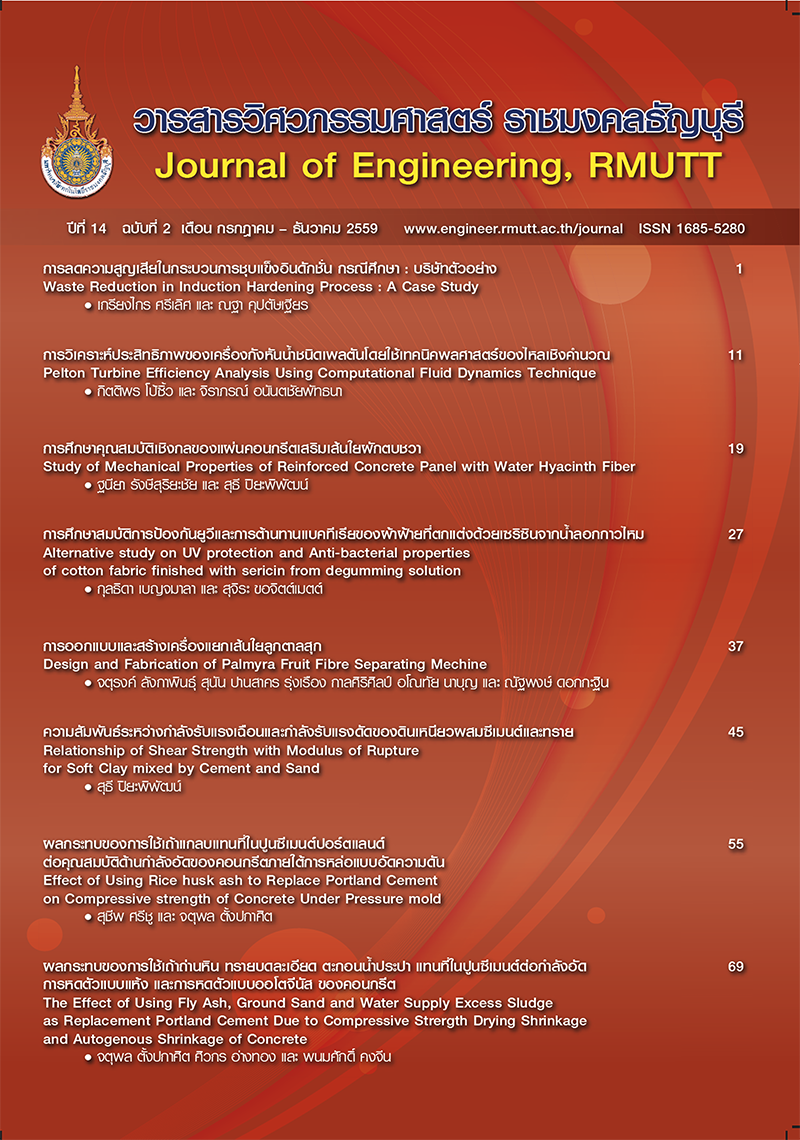การลดความสูญเสียในกระบวนการชุบแข็งอินดักชั่น กรณีศึกษา : บริษัทตัวอย่าง
Main Article Content
บทคัดย่อ
งานวิจัยนี้มีวัตถุประสงค์เพื่อศึกษา การลดความสูญเสียจากกระบวนการชุบแข็งอินดักชั่น ในขั้นตอนการให้ความร้อน (Induction) ซึ่งเป็นปัญหาหลักที่ส่งผลกระทบต่อการดำเนินงานของบริษัทจากการศึกษาข้อมูลความสูญเสียที่เกิดขึ้นในกระบวนการชุบแข็งอินดักชั่นมีจำนวนเฉลี่ย 1,459 ชิ้นต่อเดือน โดยมีการสูญเสียในขั้นตอนการให้ความร้อนเฉลี่ย 1,171 ชิ้นต่อเดือนการออกแบบสร้างเครื่องมืออุปกรณ์ช่วยในการจับยึดชิ้นงานในขั้นตอนการให้ความร้อน ช่วยในการขับหมุนชิ้นงานขณะให้ความร้อนชุบแข็งกับชิ้นงานซึ่งเป็นสาเหตุหลัก ทำให้ไม่เกิดความสูญเสียกับชิ้นงานเพลาขับ (Intermediate Shaft) จึงทำให้ลดความสูญเสียในกระบวนการชุบแข็งอินดักชั่นในขั้นตอนการให้ความร้อน ผลการวิจัยพบว่าเครื่องมืออุปกรณ์ช่วยในการจับยึดชิ้นงานในขั้นตอนการให้ความร้อนสามารถลดความสูญเสียจาก 1,171 ชิ้นต่อเดือน คิดเป็นร้อยละ 0.51 ของจำนวนชิ้นงานที่ผลิตเหลือความสูญเสียจำนวน 108 ชิ้นต่อเดือน คิดเป็นร้อยละ 0.06 และสามารถลดความสูญเสียเฉพาะกระบวนการชุบแข็งอินดักชั่นจาก 1,459 ชิ้นต่อเดือน ซึ่งคิดเป็นร้อยละ 0.63 เหลือ 284 ชิ้นต่อเดือน คิดเป็นร้อยละ 0.17 ของจำนวนชิ้นงานที่ผลิต หมายถึงสามารถลดการสูญเสียในการผลิตชิ้นงานได้ถึงร้อยละ73
Article Details
บทความ ข้อมูล เนื้อหา รูปภาพ ฯลฯ ที่ได้รับการตีพิมพ์ในวารสารแนวหน้าวิจัยนวัตกรรมทางวิศวกรรม ถือเป็นลิขสิทธิ์ของวารสารฯ เท่านั้น ไม่อนุญาติให้บุคคลหรือหน่วยงานใดคัดลอกเนื้อหาทั้งหมดหรือส่วนหนึ่งส่วนใดไปเผยแพร่เพื่อกระทำการใด ๆ ที่ไม่ถูกต้องตามหลักจริยธรรม
เอกสารอ้างอิง
ธีระวัฒน์ สมสิริกาญจนคุณ, “การปรับปรุงประสิทธิภาพกระบวนการผลิตยางท่อเพื่อลดความสูญเปล่าในกระบวนการผลิต,”ภาควิศวกรรมอุตสาหการ คณะวิศวกรรมศาสตร์ มหาวิทยาลัยขอนแก่น2552.
ยุทธณรงค์ จงจันทร์,“การเพิ่มผลผลิตสายการผลิตเตาเหล็กหล่อ,”วิทยานิพนธ์ปริญญามหาบัณฑิต วิศวกรรมอุตสาหการ มหาวิทยาลัยเทคโนโลยีราชมงคลธัญบุรี, 2554.
สาทิตย์ สินิลพันธ์,ณฐา คุปตัษเฐียร, “การลดความสูญเปล่าในกระบวนการผลิตชิ้นส่วนรถจักรยานยนต์ โดยการบูรณาการเทคนิควิศวกรรมอุตสาหการ, ”วารสารวิศวกรรมศาสตร์ราชมงคลธัญบุรี, 2553.
อำนาจ มีแสง, “การออกแบบเครื่องมือจับยึดชิ้นงานเพื่อลดความสูญเสียในกระบวนการตัดท่อยาง กรณีศึกษา โรงงานผลิตชิ้นส่วนยานยนต์,”วิทยานิพนธ์ปริญญามหาบัณฑิต วิศวกรรมอุตสาหการ มหาวิทยาลัยเทคโนโลยีราชมงคลธัญบุรี, 2554.
วรรณา พิศดวงดาว, “การลดความสูญเสียขวดพีอีทีในสายการผลิตชาเขียว โดยประยุกต์ใช้เครื่องมือทางคุณภาพ, ”วิทยานิพนธ์ปริญญามหาบัณฑิต วิศวกรรมอุตสาหการ มหาวิทยาลัยธรรมศาสตร์, 2553.
ชายชาญ แต่งผิว, “การลดความสูเสียในกระบวนการตัดแบ่งเหล็กแผ่นรีดร้อน : กรณีศึกษาโรงงานผลิตเหล็กแผ่นรีดร้อนชนิดม้วน, ”วิศวกรรมอุตสาหการ บัณฑิตวิทยาลัย มหาวิทยาลัยเทคโนโลยีพระจอมเกล้าพระนครเหนือ, 2554.
คชพล สิริทรัพย์อุดม, “การศึกษาวิจัยด้านการจัดการการผลิตเพื่อเพิ่มประสิทธิภาพทางการผลิตและลดความสูญเสีย 7 ประการ : กรณีศึกษาสายการผลิต LEVER TILE,”การจัดการวิสาหกิจสำหรับผู้บริหาร สถาบันเทคโนโลยีไทย-ญี่ปุ่น,วารสารสถาบันเทคโนโลยีไทย-ญี่ปุ่น ปีที่ 1 ฉบับที่ 1 เดือนตุลาคม 2555-มีนาคม 2556.
โกเมศร์ แจ่มจันทร์,นาย สมโชค ทรัพย์พนาชัย, “การควบคุมความถี่ 64 กิโลเฮิรตซ์ ด้วยเทคนิค PWM AUTO TUNE RESONANCEสำหรับการให้ความร้อนแบบเหนี่ยวนำ.’’มหาวิทยาลัยเซนต์จอห์น 2551.
สมนึก วัฒนศีรยกุล, “การศึกษาศักยภาพการชุบแข็งเฟืองรถไถแบบเดินตามที่ผลิตในประเทศไทย.”ภาควิชาวิศวกรรมการผลิต,คณะวิศวกรรมศาสตร์,สถาบันเทคโนโลพระนครเกล้าพระนครเหนือ, 2550.
ยุทธนา มั่นมาก, “การศึกษากระบวนการชุบแข็ง และการอบคืนไฟ ของเหล็กสปิง ผสมโครเมียมต่ำ,”วิทยานิพนธ์ปริญญามหาบัณฑิต,คณะวิศวกรรมศาสตร์,มหาวิทยาลัยเทคโนโลพระจอมเกล้าธนบุรี, 2552.
Miltenberg, J. and Wijingaard, J. 1994. The U- line balancing problem, Management Sciences, 40(10): 1378-1388.
Sury, R. J. 1971. Aspects of assembly line balancing. International Journal of Production Research, 9: 8-14.
Lowry, S.M., H. B. Maynard and G. J. Stegemerten. 1940. Time and Motion Study and Formulas for Wage Incentives, 3rd ed., NY: McGraw-Hill.
J. Choi and R. Edward Minchin. 2006. Workflow management and productivity control for asphalt pavement operations, Canadian Journal of Civil Engineering vol33, 1039-1049
Paul H.P Yeuw and Rabinda NathSen. 2006. Productivity and quality improvement revenue increment and rejection cost reduction manual component insertion lines through the application of ergonomic, International Journal of Industrial Ergonomics vol36, 367-377
S. Gangopadhyay, I. Das, and G. Ghoshal. 2006. Work organization in sand core manufacturing for health and productivity, International Journal of Industrial Ergonomics vol36, 915-920


